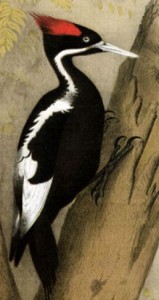The migration of Shenandoah from physical journal to virtual one and our absence from the world of literary publishing for six months has me thinking about the hunt-and-peck totemic bird to the left. The ivory-billed woodpecker(campephilus principalis), once widespread among the swampy regions of the American South, has long been considered extinct, survived by his cousin, the pileated (whose beak is black, markings different, especially the wing undersides), a pair of whom hunt grubs, flash among the trees and lift spirits in the woods near my house, despite everything “developers” from the depths of the abyss have done to destroy any living thing. The ivory bill, as you can guess, was long sought by trophy seekers, hat designers and other misguided collectors for the glory of his plumage and for his beak, which some thought a fine novelty watch fob.
The largest and most elegant of woodpeckers (sometimes over 20″ high with a 30″ wingspan), the ivory bill has had many nicknames, including “the Grail Bird” and “the Lord God Bird,” due to the expression that often accompanied its appearance. These days some call it “the Elvis bird,” as a result of all the unrecorded sightings, and one documentary film christens it “the ghost bird.” Even MIA, it attracts a lot of notice. From the number of e-mails and phone calls I’ve received since spring, Shenandoah has also been conspicuous in a spectral way.
Its shrinking habitat logged thin, its parts sought for ornamentation, the ivory bill gradually grew scarce and was for some time assumed to be and pretty much “ruled” extinct. Most ornithologists claim this erasure is irreversibly the case, despite a few supposed sightings in the wetlands near Brinkley, Arkansas and Florida’s Chatawhatchee Basin over the past few decades. Suddenly, however, the hopes of hobbyists and curiosity seekers rose. Even professors from the famed Cornell Ornithological Center claimed back in 2004-2005 to have heard its kint, kint amid the rotting trees or its more social crescendoing twitter (no kidding), and a video of a maybe-ivory/ maybe-pileated stirred questing birders to action. The ivory bills were always shy, but once fairly plentiful, especially in the Singer Tract of Louisiana. As recently as two hundred years ago Catesby painted them extensively, and Alexander Wilson wrote a comprehensive study in 1811, then shot one, just winging it, and tried to keep him as a pet. After destroying the furniture, the unappreciative guest set to work on ceiling plaster and window frame. Wilson, a dedicated naturalist, was tempted to reintroduce his new friend to the wilds, but the artist in him kept furiously sketching, and in three days the bird, which had refused to eat, was dead (via joann at http://www.dresshead.com). Audubon thought the ivory bill’s styling and colors resembled a being rendered by “the great Vandyke,” and that their preferred habitat of gloomy cypresses, Nuttall oak, tupelo and hagberry was serenaded by “the dismal croaking of innumerable frogs, the hissing of serpents, or the bellowing of alligators.” His 1831 painting of the pileated is more widely known and admired, perhaps because they were easier to find. You might think the ivory bills would have been safe in such haunted territory as its favored swamps, averse to uncomfortable places as most of us modern humans have turned out to be and wary as the birds themselves have become of our company, but logging continues and birding tourists scour the swamps, desperate for a cell phone snapshot, so the creatures either prefer to remain invisible or have in fact become extinct, though that is not the feature of their make-up I most admire. Ive adopted them as a totem in order to appreciate and perhaps emulate their survival skills, for even if they have not been seen for some time, they did hold on against the march of commerce long enough that we have film footage and sound recordings. Though those shreds of evidence are not wholly satisfying, they can be inspiring. After all, when beauty, whether natural or literary, is considered a luxury by vast segments of the population, advocates have to band together and celebrate anything beautiful that still endures, even if it’s only a ghost. Spectres aside, I like to think that somewhere in the depths of our remaining southern wetlands there’s a pair, a nest, a tribe finding ways to adapt, a new habitat, a fresh food source, a voice no one will wish to silence. Legions of fans (of ivory bills and lyrics and narratives, sonnets and parables) are keeping a sharp eye out, waiting to see what they might do next. I hope the numbers of people who have missed Shenandoah are also large, and that those who are pleased to find us on the web will not only appreciate what’s here but amplify it with your comments on both the blog and linked to each work we’re publishing. As to other manifestations of our transformation, I’ll keep you posted. Meanwhile, enjoy this first online issue of Shenandoah, which we plan to refine and polish as we learn more about both our new medium and our audience.
RTS

